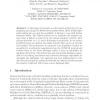Free Online Productivity Tools
i2Speak
i2Symbol
i2OCR
iTex2Img
iWeb2Print
iWeb2Shot
i2Type
iPdf2Split
iPdf2Merge
i2Bopomofo
i2Arabic
i2Style
i2Image
i2PDF
iLatex2Rtf
Sci2ools
IPOM
2005
Springer
2005
Springer
Policy-Based Fault Management for Integrating IP over Optical Networks
Abstract. In this paper we present a policy-based architecture for aggregating (grooming) IP/MPLS flows (packet-based LSPs) within lightpaths taking into account the possibility of having to cope with further transport faults. The defined policies try to minimize the negative impact when a failure is detected in the optical transport network. Such policies deal with 1+1, 1:1 and 1:N schemes of protection. In our model, IP/MPLS flows are divided into High Priority (HP) and Low Priority (LP) traffics. The architecture is composed of an Admission Control responsible for receiving the requisitions from the IP/MPLS network and forward them to the Policy Manager which in turn is responsible for applying the policies. The architecture also has a Fault Manager responsible for accounting the failures and a Resource Manager responsible for managing the lightpaths. Our approach has been implemented to validate the policies and the results showed that the defined policies decrease the number o...
| Added | 27 Jun 2010 |
| Updated | 27 Jun 2010 |
| Type | Conference |
| Year | 2005 |
| Where | IPOM |
| Authors | Cláudio Carvalho, Edmundo Roberto Mauro Madeira, Fábio Luciano Verdi, Maurício F. Magalhães |
Comments (0)

